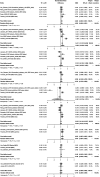Minimum spanning tree analysis of brain networks: A systematic review of network size effects, sensitivity for neuropsychiatric pathology, and disorder specificity
- PMID: 35733422
- PMCID: PMC9207994
- DOI: 10.1162/netn_a_00245
Minimum spanning tree analysis of brain networks: A systematic review of network size effects, sensitivity for neuropsychiatric pathology, and disorder specificity
Abstract
Brain network characteristics' potential to serve as a neurological and psychiatric pathology biomarker has been hampered by the so-called thresholding problem. The minimum spanning tree (MST) is increasingly applied to overcome this problem. It is yet unknown whether this approach leads to more consistent findings across studies and converging outcomes of either disease-specific biomarkers or transdiagnostic effects. We performed a systematic review on MST analysis in neurophysiological and neuroimaging studies (N = 43) to study consistency of MST metrics between different network sizes and assessed disease specificity and transdiagnostic sensitivity of MST metrics for neurological and psychiatric conditions. Analysis of data from control groups (12 studies) showed that MST leaf fraction but not diameter decreased with increasing network size. Studies showed a broad range in metric values, suggesting that specific processing pipelines affect MST topology. Contradicting findings remain in the inconclusive literature of MST brain network studies, but some trends were seen: (1) a more linelike organization characterizes neurodegenerative disorders across pathologies, and is associated with symptom severity and disease progression; (2) neurophysiological studies in epilepsy show frequency band specific MST alterations that normalize after successful treatment; and (3) less efficient MST topology in alpha band is found across disorders associated with attention impairments.
Keywords: Minimum spanning tree; multimodal; network neuroscience; network size; transdiagnostic.
© 2022 Massachusetts Institute of Technology.
Figures




Similar articles
-
The minimum spanning tree: an unbiased method for brain network analysis.Neuroimage. 2015 Jan 1;104:177-88. doi: 10.1016/j.neuroimage.2014.10.015. Epub 2014 Oct 16. Neuroimage. 2015. PMID: 25451472
-
Epilepsy surgery outcome and functional network alterations in longitudinal MEG: a minimum spanning tree analysis.Neuroimage. 2014 Feb 1;86:354-63. doi: 10.1016/j.neuroimage.2013.10.010. Epub 2013 Oct 12. Neuroimage. 2014. PMID: 24128736 Clinical Trial.
-
Disentangling age- and disease-related alterations in schizophrenia brain network using structural equation modeling: A graph theoretical study based on minimum spanning tree.Hum Brain Mapp. 2021 Jul;42(10):3023-3041. doi: 10.1002/hbm.25403. Epub 2021 May 7. Hum Brain Mapp. 2021. PMID: 33960579 Free PMC article.
-
Frontal Functional Network Disruption Associated with Amyotrophic Lateral Sclerosis: An fNIRS-Based Minimum Spanning Tree Analysis.Front Neurosci. 2020 Dec 23;14:613990. doi: 10.3389/fnins.2020.613990. eCollection 2020. Front Neurosci. 2020. PMID: 33424544 Free PMC article.
-
The trees and the forest: Characterization of complex brain networks with minimum spanning trees.Int J Psychophysiol. 2014 Jun;92(3):129-38. doi: 10.1016/j.ijpsycho.2014.04.001. Epub 2014 Apr 13. Int J Psychophysiol. 2014. PMID: 24726900 Review.
Cited by
-
Minimum spanning tree analysis of unimpaired individuals at risk of Alzheimer's disease.Brain Commun. 2024 Aug 20;6(5):fcae283. doi: 10.1093/braincomms/fcae283. eCollection 2024. Brain Commun. 2024. PMID: 39229485 Free PMC article.
-
The longitudinal relation between executive functioning and multilayer network topology in glioma patients.Brain Imaging Behav. 2023 Aug;17(4):425-435. doi: 10.1007/s11682-023-00770-w. Epub 2023 Apr 17. Brain Imaging Behav. 2023. PMID: 37067658 Free PMC article.
-
Functional Connectivity Analysis of Prej udice Among Colombian Armed Conflict Former Actors.Int J Psychol Res (Medellin). 2024 Aug 21;17(2):36-46. doi: 10.21500/20112084.7333. eCollection 2024 Jul-Dec. Int J Psychol Res (Medellin). 2024. PMID: 39927246 Free PMC article.
-
EEG Functional Connectivity Analysis for the Study of the Brain Maturation in the First Year of Life.Sensors (Basel). 2024 Aug 1;24(15):4979. doi: 10.3390/s24154979. Sensors (Basel). 2024. PMID: 39124026 Free PMC article.
-
Deciphering network dysregulations and temporo-spatial dynamics in disorders of consciousness: insights from minimum spanning tree analysis.Front Psychol. 2024 Dec 19;15:1458339. doi: 10.3389/fpsyg.2024.1458339. eCollection 2024. Front Psychol. 2024. PMID: 39749272 Free PMC article.
References
-
- Anjomshoa, A., Dolatshahi, M., Amirkhani, F., Rahmani, F., Mirbagheri, M. M., & Aarabi, M. H. (2016). Structural brain network analysis in schizophrenia using minimum spanning tree. In 38th annual international conference of the IEEE engineering in medicine and biology society (EMBC) (pp. 4075–4078). Orlando, FL: IEEE. 10.1109/EMBC.2016.7591622, - DOI - PubMed
-
- Boersma, M., Smit, D. J. A., Boomsma, D. I., de Geus, E. J. C., delemarre-Van de Waal, H. A., & Stam, C. J. (2013). Growing trees in child brains: Graph theoretical analysis of electroencephalography-derived minimum spanning tree in 5- and 7-year-old children reflects brain maturation. Brain Connectivity, 3(1), 50–60. 10.1089/brain.2012.0106, - DOI - PubMed
LinkOut - more resources
Full Text Sources
